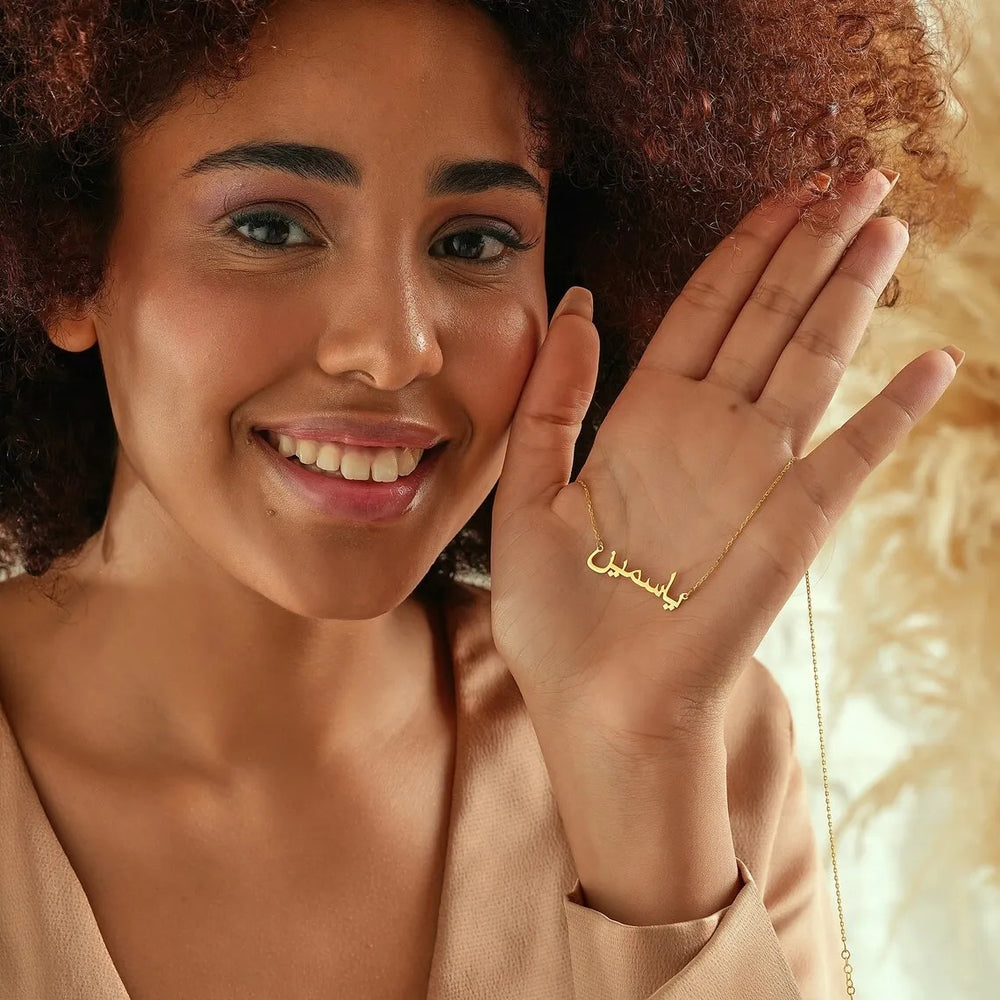Showcase your unique style with a personalised Urdu name necklace! These edgy necklaces are crafted with utmost care to accentuate its wearer's individuality. Get a stunning Urdu name necklace and stand out in the crowd! Our beautiful designs are handmade and tailored specifically for you.
Trendyz Personalised Name Necklaces in various languages are very popular all over the world. One such language is Urdu, and customers worldwide are eagerly ordering their nameplate necklaces in Urdu. So we decided to delve a bit deep into the origins and history of this beautiful poetical language.
History of Urdu Language
Urdu اُردُو is spoken as a first language by nearly 70 million people and as a second language by more than 100 million people, predominantly in Pakistan and India. It is the official state language of Pakistan and is also officially recognised in the constitution of India. The word Urdu originated from the Turkish word “Ordu,” which means the army.
Urdu and Hindi share an Indo-Aryan base, but Urdu is associated with the Nastaliq script style of Persian calligraphy and reads right-to-left, whereas Hindi resembles Sanskrit and reads left-to-right. The earliest linguistic influences in the development of Urdu probably began with the Muslim conquest of Sindh in 711. The language started evolving from Farsi and Arabic contacts during the invasions of the Indian subcontinent by Persian and Turkic forces from the 11th century onward. Urdu developed more decisively during the Delhi Sultanate (1206–1526) and the Mughal Empire (1526–1858).

When the Delhi Sultanate expanded south to the Deccan Plateau, the literary language was influenced by the languages spoken in the south, Punjabi and Haryanvi, and Sufi and court usage. The earliest verse dates to the 15th century and the golden period of Urdu poetry was the 18th–19th centuries. Urdu religious prose goes back several centuries, while secular writing flourished from the 19th century onward.
Are Hindi and Urdu the Same Languages?
While mutually intelligible and having a very similar vocabulary & grammatical structure, the written script of the two languages is different. Urdu is closely related to Hindi, a language that originated and developed in the Indian subcontinent. They share the same Indo-Aryan base and are so similar in phonology and grammar that they appear to be one language. However, in terms of lexicon, they have borrowed extensively from different sources—Urdu from Arabic and Persian, Hindi from Sanskrit—so they are usually treated as independent languages. Their distinction is notable mainly in writing systems: Urdu uses a modified Perso-Arabic script called Nastaliq (nastaʿlīq), while Hindi uses Devanagari.
From the grammatical point of view, there is not much difference between Hindi and Urdu. One distinction is that Urdu uses more Perso-Arabic prefixes and suffixes than the Hindi language.
Are Urdu and Arabic the same languages?
Arabic is one of the most used languages in the world. It has influenced many languages such as Persian, Turkish, Malay, Hindi, Urdu, Indonesian, Tagalog, Somali, Swahili, and even Spanish. Arabic can be said to be the origin of Urdu. The main difference between Urdu and Arabic is their language families; Urdu belongs to the Indo-European language family whereas Arabic belongs to the Afro-Asiatic language family.
Although the languages belong to two different families, Urdu language has several Arabic-derived vocabularies that were introduced into it via Persian, resulting in a change in sound.
It’s important to note that Urdu has its own additional unique letters which are not found in the Arabic language (such as پ, which is the ‘p’ sound). You’ve probably heard Arabs try and pronounce the word Pepsi, but it always comes out as “bebsi”. This is why. However, you can pronounce and write Pepsi perfectly fine in Urdu.
Can Arabic Speakers Read Urdu?
That’s like asking an English speaker if they can read French or Spanish … or asking a Russian if they can read Ukrainian or Kazakh. However, the pronunciation could be tragically off, which could lead to embarrassing situations. One example is the word: عرقِ گلاب. If an Arabic speaker was to read this, it would translate to dog sweat (araq Kaleb), when it should be read as (Arq-e-Gulab), which means rose water in Persian.
Can Urdu Speakers Read Arabic?
If we were to give an Urdu speaker (with no Arabic knowledge) to read something in Arabic, they would be able to read it (since it’s the same script as Urdu, but with missing accent signs). As far as comprehension goes, they would only be able make out bits and pieces of what’s written.
In conclusion, while there are some similarities between the two languages, it is important to note that the syntax is different. At the same time, it is much easier for Arabic speakers to learn Urdu and for Urdu speakers to learn Arabic because of the similarities. Perhaps this is one of the many reasons why so many Pakistanis and Indians learn Arabic in addition to English and Urdu.
Personalised Urdu Name Necklace
Always wanted to wear your name or a loved one's name on your neck in Urdu? If so, this is for you! This 18K Gold Plated Personalised Urdu Name Necklace allows you to truly express your heritage while adding a personal touch by allowing you to create a name or message to place on your neck in Urdu!
This stylish pendant features the word or name of your choice, beautifully handcrafted in Urdu writing. It comes in a beautiful box ready to be gifted!






Leave a comment